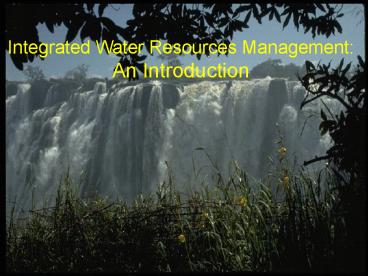Integrated Water Resources Management: - PowerPoint PPT Presentation
1 / 23
Title:
Integrated Water Resources Management:
Description:
Water impacts all aspects of life on the planet Poor water management and water ... policies review and revision IWRM Resource development, management, ... – PowerPoint PPT presentation
Number of Views:855
Avg rating:3.0/5.0
Title: Integrated Water Resources Management:
1
Integrated Water Resources Management An
Introduction
2
Course Objectives
- To provide training in key principles and themes
of Integrated Water Resources Management (IWRM). - To show IWRMs key linkages to development and to
addressing poverty reduction, water and health,
and water and food (MDGs). - To train trainers to apply IWRM principles for
awareness raising and capacity building in
advising decision makers and in preparing
curriculum in IWRM training. - To plan implementation strategy and actions for
training of trainers in IWRM at the network and
regional level.
3
About Water .
- A Single Resource has no substitute
- A Limited Resource
- A Scarce Resource (or is it?)
- Has Social, Economic, and Environmental Value
(social and environment are recent)
4
A Unique Resource
- Every organism, individual, and ecosystem on the
planet depends on water for survival. - Water impacts all aspects of life on the planet
- Poor water management and water shortages can
lead to disease, malnutrition, reduced economic
growth, social instability, conflict, and
environmental disaster.
5
The Global Water Budget
Global Water 97 Seawater 3 Freshwater
6
A Challenge to Water Management
7
(No Transcript)
8
Top 10 Largest Cities by 2015
9
The Water Scene
- Resources are scarce
- Demands are outstripping supplies
- Environmental/Ecological issues are serious
- Policy and institutional issues are complicated
- Current approach is sectoral and fragmented
- Financing is poor and options are expensive
10
Where Are We Headed?
- Decreasing per-capita availability
- Degrading water quality
- Increasing competition/conflict within sectors
and within society - Urban versus agriculture
- Haves versus have nots
- Upstream versus downstream
- National versus international
- Increasing competition/conflict with the
environment
11
Water as a Global Issue
- Water crisis has steadily moved up the global
agenda - The process is driven by
- water-related health impacts,
- rapid industrialization,
- water security, and
- awakening environmental consciousness
12
The Paradigm Shift
- The Dublin principles (1992)
- Water is a single, finite resource
- Water management and development should include
stakeholders - Water is an economic good
- Women play a central role in management and
conservation of water - The Dublin Principles have served as guide for
the global water dialogue
13
Key Water Challenges and Needs
- Integrated management of water
- Water resources economics
- Political economy of water
- Water supply and sanitation services
- Irrigation/drainage
- NRM and environment
- Water pricing and cost recovery
- Water entitlement and rights
- Water users empowerment
- Sharing of water and its benefits
- Cooperation and conflict resolution
- Energy
14
MDGs a starting point
- Goal 1. Eradicate extreme poverty and hunger
- Goal 2. Achieve universal primary education
- Goal 3. Promote gender equality and empower
women - Goal 4. Reduce child mortality
- Goal 5. Improve maternal health
- Goal 6. Combat HIV/AIDS, malaria and other
diseases - Goal 7. Ensure environmental sustainability
- Goal 8. Develop a Global Partnership for
Development
15
Approaches to Water Management
- Ad hoc
- Economic Analysis -- Single Project or Basin
- Multi-Objective Planning
- Comprehensive Multi-Purpose River Basin Planning
and Management - Strategic Planning and Implementation through IWRM
16
The Water Balancing Act
17
Integrated Water Resources Management
- A systematic process for linking water and
water-related policy, objectives, and uses to
improve decision making in - operation and management of natural resources
and environmental systems - design and implementation of programs and
policies. - A coordinating framework for integrating sectoral
needs, water and water-related policy, resource
allocation, and management within the context of
social, economic, and environmental development
objectives.
18
Why IWRM?
- Globally accepted and makes good sense.
- Key element in national water policy.
- Incorporates social and environmental
considerations directly into policy and decision
making. - Directly involves the stakeholders.
- Is a tool for optimizing investments under tight
financing climate.
19
(No Transcript)
20
IWRM can be characterized as
- A process, not a product
- Scale independent - applies at all levels of
development - A tool for self assessment and program evaluation
- A tool for policy, planning, and management
- A mechanism for evaluating competing demands,
resource allocation, and tradeoffs
21
Dimensions of IWRM
GWP
22
The Water Resources Development Process Sectoral
(or Use) Approach
23
Water Resources Development The IWRM Process































